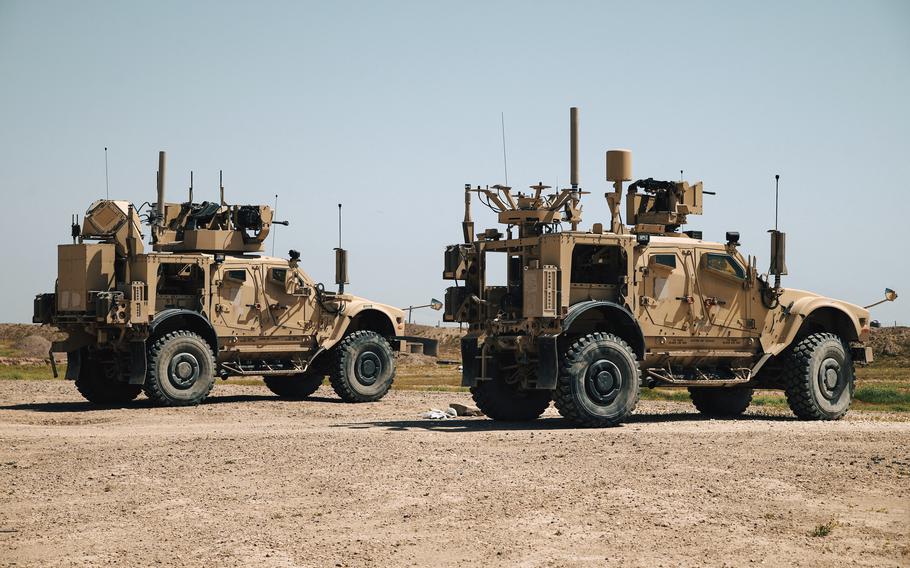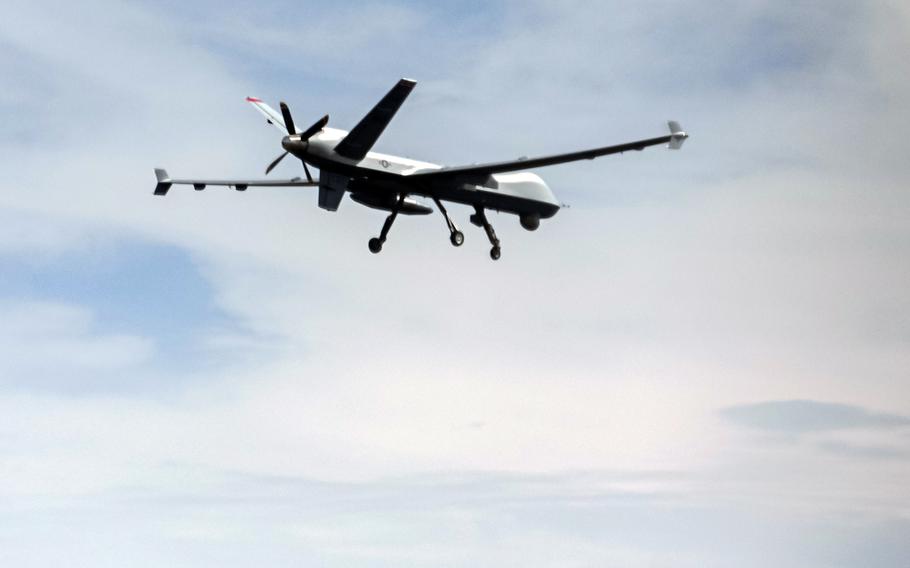
U.S. Army National Guard soldiers participate in a live-fire exercise in northeastern Syria in April 2024. American and coalition forces at Mission Support Site Euphrates in eastern Syria were targeted by a rocket attack on Sept. 26, with one striking the base. (Emma Scearce/U.S. Army Reserve)
A U.S. base in eastern Syria recently was struck by rocket fire, in what appeared to be the latest militant attack on American forces in the country since the Israel-Hamas war erupted nearly a year ago.
No personnel were injured in the early morning attack Thursday at Mission Support Site Euphrates, in which one rocket hit the base, U.S. Central Command said Monday. There were no injuries to personnel and there was no significant damage to the installation, the command said.
It wasn’t clear Tuesday what group launched the strike.
Confirmation of the attack, at least the second on the installation since July, came after U.S. forces completed targeted strikes last month in Syria that killed 37 terrorists, including senior leaders of the Islamic State and Hurras al-Din, an al-Qaida affiliate, CENTCOM announced Sunday.
Those actions were carried out Sept. 26 and Sept. 24, the command said. More than 2,000 U.S. service members are deployed to Iraq, and an additional 900 to Syria as part of a coalition fighting to prevent a resurgence of ISIS.

An MQ-9 Reaper flies over Iowa on Sept. 13, 2024. A Reaper was recently downed in Yemen, U.S. Central Command confirmed on Sept. 30. ( Nathan Osmundson/U.S. Air National Guard )
On Aug. 9, eight U.S. service members were treated for traumatic brain injury and smoke inhalation following a drone attack on Rumalyn Landing Zone near Syria’s northeastern border with Turkey and Iraq.
A few weeks prior to that, a single rocket was launched against Mission Support Site Euphrates. Militants also launched two rockets the same day in a separate attack aimed at al Asad Air Base in western Iraq.
There were no injuries or damage in either attack. But four U.S. service members and an American contractor were injured when two rockets struck al Asad on Aug. 5.
Last week’s attack on U.S. forces in Syria comes as fighting escalates in the Middle East and the threat of a wider regional conflict looms.
On Tuesday, the Israeli military launched a ground invasion into southern Lebanon after killing many of Hezbollah’s top leaders in a series of airstrikes designed to cripple the militant group.
Hezbollah began attacking Israel on Oct. 8, a day after its ally Hamas invaded Israel from Gaza.
On Monday, the Pentagon announced that the U.S. is sending thousands of troops to the Middle East to boost the security of American forces already in the region and support the defense of Israel if necessary.
American personnel in Iraq and Syria have come under more than 175 drone and rocket attacks over the past year.
Last month, American forces assigned to al Asad and Baghdad International Airport started a transition to another base in northern Iraq as part of an agreement with that will end the mission in the country, The Associated Press reported Saturday.
An unspecified number of U.S. forces will stay in Iraq in some measure to support counter-ISIS operations in Syria through 2026, AP said.
CENTCOM on Monday also confirmed the downing of another MQ-9 Reaper drone in Yemen, calling it “the latest example of malign and reckless behavior by the Iranian-backed Houthis that threatens regional stability.”
Houthi rebels claimed Monday that they had shot down the $30 million drone with a surface-to-air missile. Two more U.S. drones were shot down in September.
On Friday, the Pentagon announced that U.S. Navy ships had intercepted a barrage of Houthi missiles and drones launched into the shipping lanes of the Red Sea. No U.S. ships were hit in the attack, and no American military personnel were injured, officials said.
U.S. and coalition forces have patrolled the vital waterway in response to Houthi attacks on commercial ships that began in November.
The Abraham Lincoln Carrier Strike Group remains in the Gulf of Oman. The group includes the aircraft carrier USS Abraham Lincoln and the destroyer USS O’Kane, USNI News reported last month.
The beefed-up U.S. presence in the region also includes the Wasp Amphibious Ready Group on duty in the eastern Mediterranean Sea. Three U.S destroyers also are deployed to the eastern Mediterranean, according to USNI.
Meanwhile, the Harry S. Truman Carrier Strike Group departed its homeport in Norfolk, Va., on Sept. 23 for a scheduled deployment to the U.S. 6th Fleet area of operations, which includes the eastern Mediterranean.